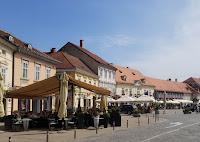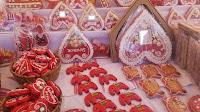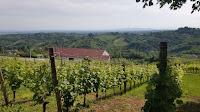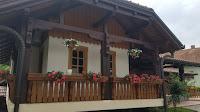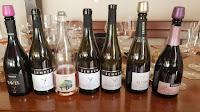I wish I had known last year, but Croatia's capital is surrounded by historical medieval towns, wine roads, and a gastronomical paradise. These are all easily accessible from a short drive from Zagreb and available for research through the Zagreb County Tourist Board. Within this parameter, I was able to spend time in the Turopolje region to the south and Plešivica to the west. Each of these regions share many cultural identities but are also quite unique and in both instances, I would recommend starting with the Muzej Turopolja in Velika Gorica and the Samobor Museum in Samobor.
Turopolje & Velika Gorica
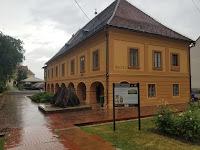

Velika Gorica is the unofficial capital of Turopolje and is situated only 16 kilometers from Zagreb and just south of the Franjo Tuđman Airport. In Old Slavonic, Turopolje means "bull field" or "field of bulls" so expect to see murals of bulls within the city. Start at the Muzej Turopolja to receive an overview of the region's history and culture where you will learn about Andautonia (the seat of an Illyrian tribe and a Roman municipality), the Turopolje pig (an indigenous breed where the first written record dates back to 1352), the Coat of Arms of numerous noble families in the Free City, and the Turopolje wooden architecture - whether for housing or wooden chapels. I didn't get to visit any wooden chapels but according to the tourist board, "the wooden chapel of St. Barbara in Velika Mlaka is the most attractive and certainly the most representative example of wooden church architecture in Croatia". However, the Muzej Turopolja provides an interactive display showing the German or Croatian joints used for building these structures. As for craft beverages, plan a tasting of brandies and gin at
Brigljevic Distillery, or ask around for homemade wine or rakija. I was fortunate enough to have a tour of the private vineyards of Nikola Hrvacic and taste his award-winning Vermouth.
Samobor Samobor is a picturous medieval town located west of Zagreb on the eastern slopes of the Samobor hills which separate Slovenia from Croatia. It has played a significant role in Croatia's national identity starting with it becoming a free royal town in 1242 as established by King Béla IV of Hungary. The Samobor Museum documents this and many other instances of promoting the Croatian language and identity in a town located at the crossroads of the Austrian Empire. This might also explain why there are so many items designated by the EU or UN as culturally and historically significant to Croatia. This includes the aromatized wine
Samoborski Bermet and
Muštarda -- a sweet and spicy sauce made from local mustard seeds and sweet grape must (See
Samoborski Bermet - Croatia's First Protected Aromatized Wine). There's also the light and creamy Samoborska kremšnita, crystal, and the
Gingerbread and Licitar Hearts which are on the list of the Intangible Cultural Heritage of Humanity. Licitars are hard, sweet, decorated biscuits that in Croatia are heart-shaped and painted red, then decorated with pictures, small mirrors, and verses or messages.
Plešivica Wine Road The majority of our time was spent visiting wineries along the
Plešivica Wine Road (the smallest wine region in Croatia) from our base at the
Princess Hotel in Jastrebarsko -- 25 km south of Samobor. In two days we managed to visit 6 of the 35 wineries on the wine road starting with the highly regarded
Korak Family Estate Winery. This is a family estate, run by the 4th and 5th generations of grape growers and located on a family home and farmhouse that dates from 1900. Velimir Korak currently operates the winery along with his youngest son Josip. Across multiple estates throughout Plešivica, they grow Rhine Riesling, Sauvignon, Chardonnay, Pinot Grigio, Pinot Noir, Syrah, and Portuguese with most of the estates situated between 350m to 400m above sea level and separated from Slovenia by the Žumberak and Samobor Mountains. The family has also been instrumental in developing Plešivica as a gastronomic destination as a result of Michelin star chef, and older son, Bernard Korak returning home to open the farm-to-table Korak Restaurant within the renovated winery. We tasted through most of their portfolio which includes still, sparkling, and amphora amber wines starting with the Sparkling Rose and Blanc de Blanc. Both are elegant and refreshing with a bottle of the Sparkling Pinot Noir ready to be opened here at home. I also really enjoyed the 2021 Sauvignon Blanc, 2020 Rhine Riesling, and the 2019 Križevac & Cimbuščak Pinot Noir - the latter a blend from two different estates. This was an eye-opening experience that introduced us to the prevalence and quality of these grape varieties in Plešivica.
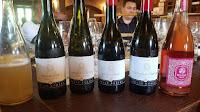
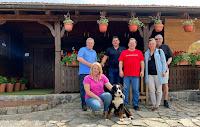
is situated in a valley surrounded by vineyards, near Jastrebarsko, and the rustic, wooden tasting room is a destination itself. The family has an interesting pedigree story to tell in that during the 1950s, Robert's Grandfather discovered a wine competition in Zagreb and created a homemade label for his homemade wine. After being awarded a diploma (medal), authorities threw him in jail because he was not authorized to produce wine. Fortunately, he was released rather quickly as there was no real regulation that he had violated. This award-winning winemaking was on display during our visit as we tasted several of Robert's wines while his wife Sanda served us Soparnik, a traditional Croatian dish of savory pie with fresh cheese and herbs. The tasting started with a mystery wine,
Veltlinac Cirveni, which we later determined to be
Roter Veltliner. This Austrian grape has been planted in Plešivica for at least 300 years old of roots in Plešivica and makes a light wine with a noticeable floral aroma and plenty of acidity. Next, we were presented with solid representations of
Pinot Sivi (Gris) and
Rhine Riesling -- tart, citrus, and minerally driven for the first; full mouthfeel and structured for the second. Finally, we tasted another Pinot Noir which strengthened our conviction of the quality of this varietal wine in Plešivica. The
2018 Pinot Crni was fermented in an open barrel and spent 12 months in small used barrels. This is an elegant wine that starts with velvety slightly tart cherries, texture, and firm tannins. Excellent.
Šember is a three-generation family winery farming various estates in
Pjenusac and with an extensive sparkling wine portfolio. The winery is currently run by Zdenko Šember and his wife Ivanka with his parents (Ružica and Stjepan) passing along their experience to the younger generation -- Nikola, Lucija, and Klara. The family began releasing wine under their own label in 1991, their first sparkling wine in 1997, and their first amphora wine in 2011. Always innovating. We started with the delicious
Šember Brut Rosé - a fruity raspberry and effervescent Pinot Noir. This was followed by the
Šember Pjenusac Brut, a traditionally made Blanc de Blanc but using Chardonnay, Pinot Blanc, and Plavec Žuti - the latter providing increased acidity. Expect pears, green apples, and yeasty bread. The final sparkling wine was the
2018 Pavel, a label created only in the best of years, This is a blend of Chardonnay (90) and Plavec Žuti (10) and is exceptional. Moving to the still wines, we started with the dry
2019 Rhine Riesling which provides a complex arrangement of grapefruit, other citrus, and green apples. The skin-contact amphora
2017 Rhine Riesling followed that had a bigger mouthfeel, and more tannins, but remained considerably fresh. Once again an incredibly elegant Pinot Noir rounded out our tasting with the
2018 Pinot Crni. This is a fresh wine where the grapes were planted on south-facing slopes and benefited from cool nights. The barrel aging in a combination of new and used French oak, elevated its profile without hampering the cherry flavors.



